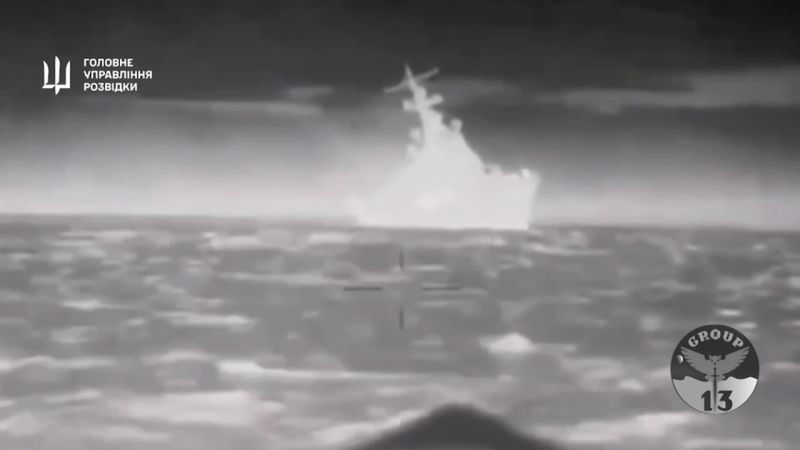Ukrainians have had little to celebrate as the second anniversary of the Russian invasion looms, but continuing successes in the Black Sea are one surprising bright spot.
On Wednesday, Ukraine’s Defense Intelligence announced it had attacked and destroyed a large landing ship of Russia’s Black Sea fleet – the Caesar Kunikov – with maritime drones off the coast of Crimea. There has been no official comment from Russia about Ukraine’s claim.
Ukraine has virtually no navy of its own, but technological innovation, audacity and Russian incompetence have given it the upper hand in much of the Black Sea. It has now destroyed or disabled more than 20 Russian naval ships in the region, a third of Russia’s total Black Sea fleet.
That in turn has secured a maritime corridor that allows Ukraine to export much of its grain and other produce from ports such as Odesa – an economic boon at a time when the economy has been battered by the conflict.
Amid a bleak winter on the frontlines in the eastern regions of Donetsk and Kharkiv, President Volodymyr Zelensky was at least able to say in an interview this month: “Russia lost many ships, and in the Black Sea we managed to build a grain corridor, so this pragmatic part of the operation with effects on the economy was conducted in a positive way.”
Before the Russian invasion, Ukrainian agriculture accounted for about 11% of the country’s GDP. Agriculture was also a critical source of export revenue (some 40% of the total), which both sustained Ukraine’s farms and influenced global grain prices. Almost all the produce was shipped through the Black Sea.
In July last year, Russia quit the UN-brokered Black Sea Initiative, which had allowed Ukraine safe passage to ship 31.5 million tons of grain and other food products from its ports to world markets. The deal had lasted just under a year.
Rather than fold, the Ukrainians declared a unilateral “Black Sea Humanitarian Corridor” for merchant shipping and stepped up its use of maritime drones and missile attacks against Russia’s Black Sea fleet. The corridor hugs the Ukrainian coast before reaching the waters of two NATO states, Romania and Bulgaria.
The result: Ukraine has shifted 22.6 million tons of cargo through the corridor in just seven months, according to both Ukrainian and US officials. More than 700 ships have used the passage to the Bosphorus and beyond to world markets.
In January alone, according to the Economy Ministry, $1.9 billion worth of Ukrainian exports were shipped by sea (out of a total of $3.4 billion.) That is less than pre-war volumes but is growing every month. Some ships have offset the risk by taking up insurance through a scheme called UNITY, created by the Ukrainian government together with a pool of insurance companies.
When the Black Sea Initiative collapsed, Russia launched drone and missile attacks against port and storage infrastructure and threatened to (but did not) sink vessels carrying cargo to and from Ukraine.
But the Ukrainian military has taken the battle to Russia. One-third of the Black Sea fleet has been disabled or destroyed, and the remaining ships rarely venture into the western half of the sea. In August, Russia withdrew some of the Black Sea fleet from its headquarters in Sevastopol to relatively safer ports on the Russian coast. It has also used nets and sunken barges to try to defend against maritime drones.
Zelensky said during his December visit to Washington that “Russia is hiding the remnants of its naval fleet in remote bays.”
Pletenchuk added that when Russia began its invasion, it had 13 landing ships in the Black Sea. Only five are now serviceable.
Both Wednesday’s attack and the previous one – against a Russian missile ship, the Ivanovets, off the coast of Crimea at the end of last month – were carried out by what the Ukrainians call the MAGURA (Maritime Autonomous Guard Unmanned Robotic Apparatus), which also happens to be the name of a sea goddess.
Drones, missiles and sabotage
Ukraine has pioneered the development and deployment of a range of maritime drones, using them to attack Russian naval ships at sea and when moored at ports in both Crimea and Russia. Both Defense Intelligence and the Security Service, the SBU, have pursued their development.
One of the Black Sea fleet’s main landing ships, the Olenogorsky Gornyak, was crippled by a maritime drone in its home port of Novorossiysk in August, days after the Black Sea Grain Initiative collapsed.
Novorossiysk, near the Russian city of Krasnodar, is Russia’s largest port by volume of cargo handled and is a base for Russia’s Black Sea Fleet. One Russian military commentator noted that “it is time to realize that the enemy has a ‘long arm’ and can reach very far with it.”
A Russian chemical and oil tanker – the SIG – was damaged days later by a sea drone in the Kerch Strait.
The speed with which the Ukrainians have developed their fleet of maritime drones has been impressive. The MAGURA-5 is about 5 meters long and has a range of some 450 nautical miles, according to its manufacturer. It is scarcely visible above the waterline and has a payload of 700 pounds (320 kilograms), enough to do serious damage to most ships.
It is also maneuverable, so was able to evade the Ivanovets’ AK-630M defensive guns.
Russian military bloggers have criticized the navy for not doing more to counter the threat. After Wednesday’s attack one of them, Rybar, said that “time after time the Black Sea Fleet is incompetent and unable to repel attacks by Ukrainian formations.”
Ukraine has also used long-range missiles supplied by the UK and France to hit Russian vessels in port in Crimea as well as inflict extensive damage last September on the Black Sea fleet headquarters in Sevastopol, a humiliating blow.
Sabotage and missile attacks against Russian radar and other installations in Crimea have also helped blunt the Russians’ capacity to project power into the Black Sea. So have special operations against Russian-occupied drilling rigs and the expulsion of Russian forces from Snake Island in 2022.
In January the Ukrainians claimed that a special ops unit had taken out a Russian Neva-B radar station (which detects surface shipping) on a platform off the coast of Crimea. The group approached the platform by sea and attached explosives which were then detonated.
However, there are still risks to commercial shipping using the western Black Sea. There have been frequent Russian drone and missile attacks against Odesa, the largest port. The latest was this week.
“The enemy’s priority was once again the coastal belt of infrastructure and agricultural facilities,” Ukraine’s southern command said.
There is also a risk from mines. At least one ship was damaged by a floating mine of unknown origin off the coast of Romania late last year. But the vast majority of vessels have traveled safely to and from Odesa and other Ukrainian ports. Turkey has offered to assist in mine-clearance.
Russia is unlikely to be able to tilt the balance in the Black Sea back in its favor. An international treaty signed in 1936 – the Montreux Convention – prohibits any country that’s at war from moving its ships through the Bosphorus. This means that Moscow cannot reinforce its now-diminished fleet with other naval forces.
Since the beginning of Russia’s invasion, aerial drones have been a vital part of each side’s arsenal – for surveillance, intelligence and strikes. In the last six months, the Ukrainians have used the maritime equivalent to turn the balance of power at sea on its head – and revived an economic lifeline in the process.






































